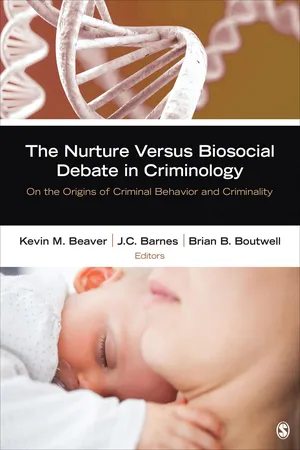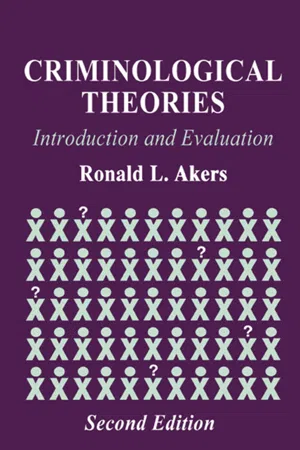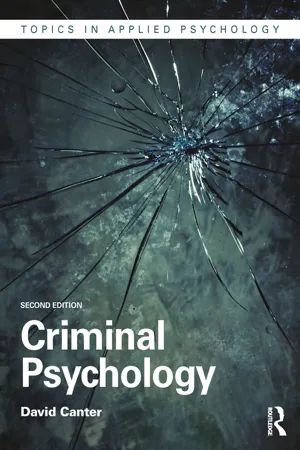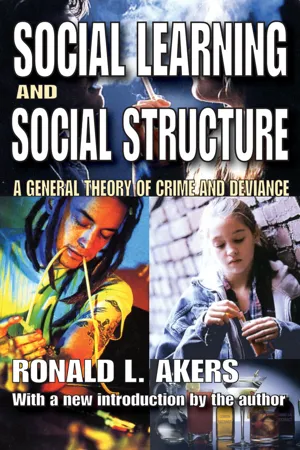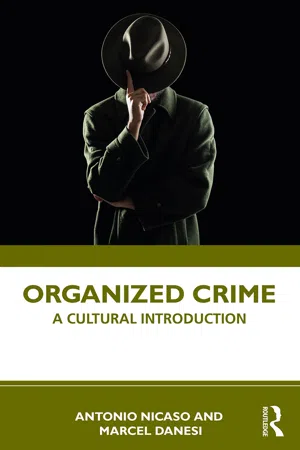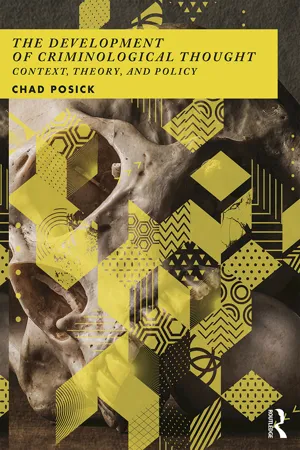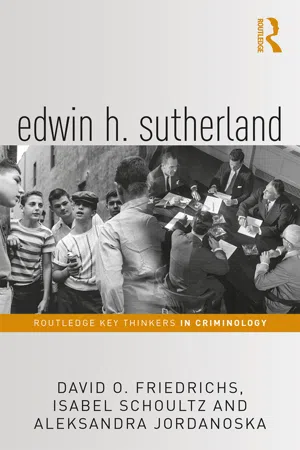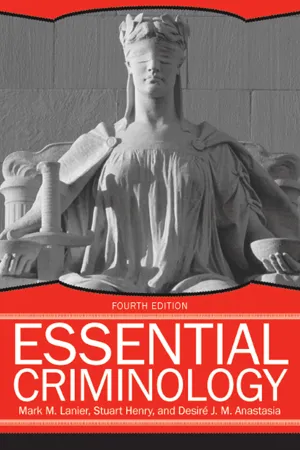Psychology
Differential Association Theory
Differential Association Theory, proposed by Edwin Sutherland, suggests that criminal behavior is learned through interactions with others. Individuals are more likely to engage in criminal activities if they are exposed to favorable attitudes and definitions of such behavior. This theory emphasizes the role of social environment and peer influence in shaping an individual's likelihood of engaging in criminal behavior.
Written by Perlego with AI-assistance
Related key terms
Related key terms
1 of 4
Related key terms
1 of 3
10 Key excerpts on "Differential Association Theory"
- eBook - ePub
The Nurture Versus Biosocial Debate in Criminology
On the Origins of Criminal Behavior and Criminality
- Kevin M. Beaver, J. C. Barnes, Brian B. Boutwell(Authors)
- 2014(Publication Date)
- SAGE Publications, Inc(Publisher)
PART IITHEORETICAL PERSPECTIVESPassage contains an image
7Learning Theories of CrimePromises and PotentialJonathan R. BrauerUniversity of Nebraska at OmahaJonathan D. BolenUniversity of Nebraska at OmahaA Brief History of Learning Theories of CrimeIn 1939, Edwin Sutherland advanced criminological theory by presenting an explicit statement of Differential Association Theory in the third edition of his Principles of Criminology textbook. Dissatisfied with the fragmented multiple factor explanations that were common in American criminology at the time, Sutherland developed the principles of differential association with the goal of providing a general theory that promised to explain all known patterns of crime (Sutherland, 1973). The basic premise was attractively simple; he posited that criminal behavior, like all human behavior, is learned via communication and interaction within social groups. Differential Association Theory was not the first general social theory to depict crime as learned behavior—in the late 19th century, French sociologist Gabriel Tarde (1903/1962) postulated that criminal behaviors are learned through a general process of behavioral imitation (see also Rafter, 2011). However, the original statement of Differential Association Theory and its later refinements (e.g., Sutherland, 1947, 1973; Sutherland & Cressey, 1966) now constitute one of the most well-known, oft-tested, and widely supported theories of crime (Akers, 2009; Matsueda, 1988).Differential Association Theory (DAT) assumes that societies contain conflicting normative codes and that individuals learn specific values primarily though frequent interactions within salient social groups. The theory posits that the likelihood of an individual engaging in criminal and deviant behaviors depends on the relative exposure to social patterns that are favorable versus unfavorable to law violating behavior. Associations with criminal patterns are expected to result in the learning of specific techniques and skills necessary to engage in crime and in learning crime-favorable cognitive definitions, which include motives, drives, or rationalizations that define crime as appropriate in certain situations. Individuals who commit crime, then, presumably have learned requisite techniques and an excess of definitions marking criminal behavior as appropriate in certain situations, through frequent exposure to salient criminal patterns (Sutherland & Cressey, 1966). - eBook - ePub
Criminological Theories
Introduction and Evaluation
- Ronald L. Akers(Author)
- 2013(Publication Date)
- Routledge(Publisher)
the “principle of differential association.” This is the principle that a person commits criminal acts because he or she has learned “definitions” (rationalizations and attitudes) favorable to violation of law in “excess” of the definitions unfavorable to violation of law.It is not a simple theory of association with “bad companions,” nor does it speak of association with particular kinds of people. Rather, it is directed at learning criminal behavior in communication with criminal and non-criminal “patterns” and “definitions.” The theory explains criminal behavior by the exposure to others’ definitions which are favorable to criminal behavior, balanced against contact with conforming definitions. Although one expects that law-violating definitions are typically communicated by those who have violated the law, it is possible to learn law-abiding definitions from them, just as one can be exposed to deviant definitions from law-abiding people (Cressey, 1960 :49). The seventh principle in the theory makes it clear that the process is not a simple matter of either criminal or non-criminal association, but one that varies according to what are called the “modalities” of association. That is, if persons are exposed first (priority), more frequently, for a longer time (duration), and with greater intensity (importance) to law-violating definitions than to law-abiding definitions, then they are more likely to deviate from the law.After Sutherland’s death, Donald R. Cressey revised Principles of Criminology from the fifth through the tenth editions. Cressey became the major proponent of differential association, clarifying it and applying it to a number of different areas in criminology (see Akers and Matsueda, 1989 ). However, in all of the revisions of the text, Cressey purposely left the original nine statements of Differential Association Theory unchanged from the way Sutherland had them in 1947. After Cressey’s death, David F. Luckenbill revised the text for its eleventh edition (Sutherland, Cressey, and Luckenbill, 1992 - eBook - ePub
- David Canter(Author)
- 2017(Publication Date)
- Routledge(Publisher)
An interesting and important aspect of Sutherland’s theory is that criminals are not seen as having different needs or values from non-criminals. It is how they interpret and act on those needs and values that distinguishes them. This contrasts with the biological and many of the psychological explanations reviewed in earlier chapters. Those explanations suggest there is something radically different about criminals. Sutherland’s theory does not.Sutherland’s theory, then, is called Differential Association Theory because it postulates that it is the relationships with a particular subset of people, who are different from the law-abiding majority, which is the main cause of criminality. It is regarded as a general theory for all crimes, but its focus is on how young people become involved in crime. The emphasis is on how delinquency is learned through a process of communication with other people – usually small intimate peer groups (Coleman & Norris, 2000). However, a wider range of illegal activity has been explained using the idea of differential association. For example, Chappell and Piquero (2004) have shown it helps to explain police corruption. Also, Akers and Silverman (2004) have argued that terrorists are influenced to carry out their violent actions by accepting an ideology and identity generated from contact with peers and membership of reference groups, where attitudes, beliefs and values justify violence as a means to a worthwhile end.The consideration of terrorism points to the fact that the learning of criminal behaviour does not have to develop through association with criminals, but with people who support or imply favourable attitudes to illegal activity. For example, parents may be teaching their children to be dishonest by not reporting an error in payment for a purchase, even if they constantly tell their children that it is wrong to steal. Or, in the terrorist context, parents may insist that their children are religiously orthodox, sowing the seeds for a radical interpretation of what that might mean. - eBook - ePub
Social Learning and Social Structure
A General Theory of Crime and Deviance
- Ronald Akers(Author)
- 2017(Publication Date)
- Routledge(Publisher)
The first focuses on the situation (or the personal pathologies of individuals), and the latter focuses on the processes existing before the situation (not the biological meaning of genetic). The Differential Association Theory was in this sense more a genetic than a mechanistic theory of factors at work in the immediate circumstances. However, differential association operates at the nexus of the "person-situation complex" because the situation is defined "by the person in terms of the inclinations and abilities which the person has acquired up to that date" (Sutherland, 1947:5) The final version of Differential Association Theory (Sutherland, 1947:6-7) was presented in a nine-statement format, with accompanying commentary: 1 Criminal behavior is learned. Negatively, this means that criminal behavior is not inherited, as such; also, the person who is not already trained in crime does not invent criminal behavior, just as a person does not make mechanical inventions unless he has had training in mechanics. Criminal behavior is learned in interaction with other persons in a process of communication. This communication is verbal in many respects but includes also "the communication of gestures." The principal part of the learning of criminal behavior occurs within intimate personal groups. Negatively, this means that the impersonal agencies of communication, such as movies and newspapers, play a relatively unimportant part in the genesis of criminal behavior. When criminal behavior is learned, the learning includes (a) techniques of committing the crime, which are sometimes very complicated, sometimes very simple, and (b) the specific direction of motives, drives, rationalizations, and attitudes. The specific direction of motives and drives is learned from definitions of the legal codes as favorable or unfavorable. In some societies an individual is surrounded by persons who invariably define the legal codes as rules to be observed, while in others he is surrounded by persons whose definitions - eBook - ePub
Organized Crime
A Cultural Introduction
- Antonio Nicaso, Marcel Danesi(Authors)
- 2021(Publication Date)
- Routledge(Publisher)
Differential Association Theory claims, in a phrase, that an individual who joins a criminal gang is influenced to do so by observing other individuals who are believed to be “in the know” and because there is pressure to join from peers in the gangs. Interactions with the gang are seen as shaping the individual’s understanding of how the OC provides a means to belong to something meaningful.Differential Association Theory
- 1 Criminal behavior is learned via a process of interaction and intercommunication with criminals.
- 2 Developing criminal behavior involves learning the techniques, motives, drives, rationalizations, and attitudes of the gang members through a form of peer pressure.
- 3 An individual does not necessarily become a criminal under peer pressure, but he will be predisposed by such pressure to rationalize his choice to join.
- 4 Mechanisms of rationalization are activated early on, allowing the individual to justify his choice of criminality, including explaining why he veered towards the crime group.
- 5 An individual becomes predisposed to criminality when there is no clear condemnation of the criminal lifestyle in his environment – a situation that leads to what is called the “social proofing” of the individual, who is inclined to assume that the criminals possess more knowledge about the world than anyone else.
- 6 Differential associations vary in frequency, duration, priority, and intensity, affecting if and how a prospective gangster will behave.
Differential Association Theory does not suggest, however, that the mere interaction with criminals will invariably lead an individual to criminal behavior. It assumes intentionality on the part of the individual, whereby he might come to see deviance in social behavior as “normal.” Sunderland’s theory was elaborated on by sociologists Robert Burgess and Ronald Akers in 1966, calling their version, differential-reinforcement theory. They cast aside Sutherland’s view that criminal behavior was learned in primary reference groups (those in an individual’s environment), indicating that it can be acquired in various kinds of situations outside the primary environment. In addition, they suggested that criminal behavior could result from non-social factors, such as the influence of drugs on an individual’s psychological and social mindset, which could contribute to the adoption of deviant behavior by the individual. Moreover, an individual might make a rational decision to join a gang not just through imitation but also on the basis of past experiences in order to calculate the effectiveness of his future behaviors. The latter view is part of so-called rational choice theory - eBook - ePub
The Development of Criminological Thought
Context, Theory and Policy
- Chad Posick(Author)
- 2018(Publication Date)
- Routledge(Publisher)
As his own contribution, Sutherland offered a sociological perspective on criminology that became the guiding paradigm in criminology for much of the twentieth century. Today, sociological explanations of crime and criminality remain prevalent, but efforts to integrate biological, psychological, and sociological theories have become increasingly popular, particularly in addressing the nature vs. nurture debate 3 which will be the focus of later chapters. Theory As a sociologically trained criminologist from the Chicago School, Edwin Sutherland chose to focus on the social aspects of criminal behavior as opposed to the biological origins that emanated from the Italian School. However, instead of focusing as much on place as did his predecessors, Sutherland believed that crime is the result of learning from people to whom one is close. Crime, therefore, is taught from one person to the next. It is not so much the place that promotes delinquency as the people who reside in those places and how they reinforce each other’s behavior. He called this idea “differential association.” Because people associate with different peers and have different friends, they learn different things from one another (this is the “differential” part of differential association). If those with whom someone associates commit crime, the person is likely to learn that behavior and continue to do it. If close associates do not commit crime and instead conform to appropriate behavior, the person is likely to be non-criminal or learn to quickly reshape their poor behavior. Differential Association Theory survived relatively untouched for several decades until the work of Ronald Akers in the 1960s. Akers agreed with much of Sutherland’s theory but saw a hole in his work. While Sutherland adequately described the association between people in society, he failed to elaborate upon exactly how they learn from one another and what maintains this behavior over time - eBook - ePub
- David Friedrichs, Isabel Schoultz, Aleksandra Jordanoska(Authors)
- 2017(Publication Date)
- Routledge(Publisher)
The concept of social disorganization is useful for hypothetically explaining crime rates across groups, as well as crime rates over time, though it does not explain the content of criminal behavior nor the reasons for the conflict in standards (Sutherland 1961:256). Crime proliferates when communities are socially disorganized (Sutherland 1983). Sutherland also used this aspect of his general theory to analyze the distribution of corporate violations across industries and over time. Altogether, Sutherland spent considerable time refining his individual-level mechanism of differential association, but “devoted much less time to the more sociological theory of differential social organization, which consequently never progressed beyond its original rudimentary form” (Matsueda 2006:4). Perhaps this is the reason behind the significant discrepancy between the number of tests and the extent of refining the Differential Association Theory, in comparison to the modest mentions of social disorganization.Critiques of and modifications to the theory of differential associationThe principal criticisms of the theory of differential association have two core themes: (1) deficiencies in the theoretical arguments; and (2) deficiencies in relation to testing. The claim for differential association as a “general” theory of crime has been challenged by those who question the validity of any general theory; these issues are addressed elsewhere in this book. Additional theoretical criticisms include the claim that the theory is tautological; that the processes relating to differential association are insufficiently developed; that the macro-level (societal) factors are not adequately integrated with the micro-level (interactive) processes; and that relevant factors other than exposure to values and behavior promoting crime are disregarded (Coleman 1992; Laub and Sampson 1991). Such criticisms incorporate inattention to the structural conditions in society that promote engagement in criminal conduct in the first place; the typically “aging out” of engagement in criminal behavior by most criminals, and the complex individual factors that promote desistance from involvement in criminal behavior by some of those who are in a criminogenic environment.p.39From the outset, it has proven challenging to demonstrate the validity of the theory of differential association with empirical studies and tests (Bruinsma 1992; Matsueda 2006). Key concepts, which Sutherland failed to define precisely, have proven difficult to operationalize (Bruinsma 1992; Tittle, Burke and Jackson 1986). Sutherland’s former student and disciple, Donald Cressey (1960:57), conceded the difficulty of subjecting the theory of differential association to rigorous empirical testing. The relative absence of rigorous testing of the theory of differential association has influenced negatively its standing (Adams 1973; Hagan 1973; Tittle, Burke and Jackson 1986). It doesn’t follow that the theory has experienced wholesale rejection. - eBook - ePub
- Kimberly Cook(Author)
- 2019(Publication Date)
- Routledge(Publisher)
7 Theoretical DiversityChapter Outline
7.1 Social Learning Theory
Stemming from the weak areas within Differential Association Theory, Akers developed the Social Learning Theory as it relates to deviant behavior in order to explain how and why individuals engage in criminal behavior. Using the lessons from Behavioral Psychology, Akers adapted the theory and concepts to explain deviance as a Social Learning theory. The starting point is that social behavior, counter to other theories, is a cognitive process where personality and environment reciprocally interact. Learning is accomplished through rewards and punishments as well as observations, according to this theory.Differential Reinforcement
C. Ray Jeffery's theory of differential reinforcement states that a criminal act occurs in an environment where the actor has been reinforced for behaving in this manner, and the aversive consequences have not successfully dissuaded further behavior. [This does not indicate why the individual did the behavior in the original instance.] According to follow-up research by Burgess and Akers, social behavior responds to a complicated set of stimuli, rewards, and punishments. Criminal behavior is learned in seven stages: direct conditioning or imitation; through social interaction with others; in small groups; with effective and available reinforcers; the norms to which those reinforcers are applied; when the normatively applied behavior is more highly reinforced than non-criminal behavior; and results from the amount, frequency and probability of reinforcements. The theory must explain all seven of these stages. There are two basic components to the theory: - eBook - ePub
- Wilhelm Roepke(Author)
- 2017(Publication Date)
- Routledge(Publisher)
Each person constructs his own “reality world,” his own view of himself and all that is about him. However, it is only as he participates in the worlds of others that he is able to develop his own world. In other words, by occupying space with others in a social setting, we share a common symbolic environment.While the reality world of each individual is his and his alone, it does, of course, have many aspects in common with the reality worlds of other people. The extent to which our reality worlds are alike seems to depend on the extent to which we have shared similar experiences and similar purposes.12Shared meanings are provided for most persons by membership in some kind of social group. According to reference group terminology, social groups furnish members with a frame of reference for the organization of perceptions and experiences.13 Persons act, then, in reference to the perspectives of their groups. Furthermore, the actions of persons are in part an attempt to preserve and enhance social status within their groups. Consequently, an explanation of variations in the behavior of persons may be sought in the context of group experiences.The theory of differential association provides such an explanation of “criminal” behavior.14 In this view, all persons acquire their behavior during associations with others. Some, however, become criminal because the substance of their associations involves an excess of definitions favorable to the violation of the law. The theory of differential association is thus an extension of the basic theoretical perspective of the socialization process that occurs in the context of primary groups.15 The learning of “criminal” behavior patterns is not fundamentally different from other socialization during which the individual is differentially exposed to various norms regarding some socially significant form of behavior.The problem in the theory of differential association, however, has been not so much theoretical as empirical. Few systematic guides are provided for empirical verification of the theory. Moreover, the theory was formulated at such a high level of abstraction that it has not been possible to test it with empirical data. At best, it has been subject only to partial testing through research on the variables of association, including the frequency, duration, priority, and intensity of association. On the basis of these limited studies, nevertheless, it has been shown that persons who associate with delinquents (however defined) report more or engage in more alleged delinquent behavior than those who associate with others.16 - eBook - ePub
- Mark M. Lanier, Stuart Henry, Desire' J.M. Anastasia(Authors)
- 2018(Publication Date)
- Routledge(Publisher)
The policy implications associated with Differential Association Theory are relatively straightforward. If socialization in small groups provides an excess of definitions favorable to law violation, the implication for prevention is to keep young and impressionable individuals away from such groups as well as educate and train them to resist the messages of such groups. For those already influenced, “treatment” intervention involving resocialization is consistent with the theory’s general principles. Specific prevention programs that follow from this theory include peer-led interventions, resistance-skills training, and personal and social skills training. In a review of research on such programs, however, Gorman and White noted that these “were shown to be of minimal effectiveness and conceptually limited in that they fail to address the complexity of the relationship between group associations and delinquency” (1995, 149). Gorman and White argued that because the relationship is reciprocal, it is insufficient to intervene at the adolescent peer-group level since doing so ignores the parent-child interaction in earlier years that led to involvement with antisocial peers in the first place. They suggested that family-based and community programs seem to be more conceptually consistent with Differential Association Theory than the school-based skills programs, but the effectiveness of such programs has not yet been adequately demonstrated.Also overlooked in the policy arena is the role of the law and public policy in influencing definitions favorable or unfavorable to law violation. For example, clearer and simplified laws provided by the dominant mainstream culture are indicated. A related policy would be to publicly proclaim the law and reasons for following it; the media may provide an effective format for delivering this message.Limitations of Differential Reinforcement TheoryEmpirical research has extensively tested differential reinforcement theory. Several large-scale studies (Akers et al. 1979; Krohn et al. 1985) have found it to be supported. Sellers et al., however, criticize narrative studies, stating that “the theory appears to have attracted a great deal of consensus on its predictive accuracy. This conclusion, however, has been based primarily on narrative reviews of numerous, widely disparate empirical tests of the theory,” which can be compromised by subjective factors (2000, 1). Nevertheless, their own meta-analysis summarizing one hundred and forty other studies confirmed this support.
Index pages curate the most relevant extracts from our library of academic textbooks. They’ve been created using an in-house natural language model (NLM), each adding context and meaning to key research topics.
Explore more topic indexes
Explore more topic indexes
1 of 6
Explore more topic indexes
1 of 4
